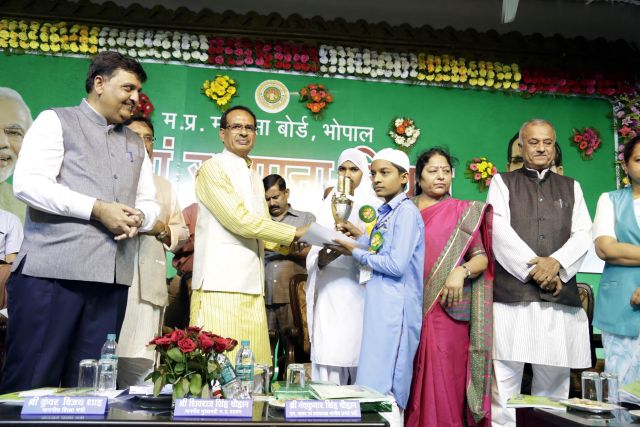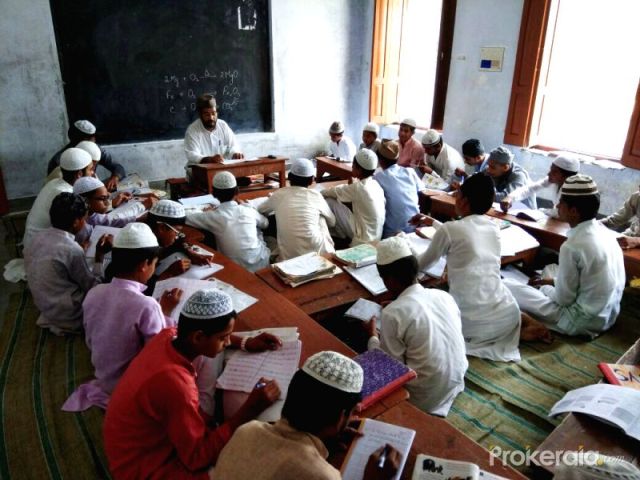
by Editor | May 25, 2021 | News, Politics
 Patna : Prime Minister Narendra Modi on Saturday said it was a “blot” that Indian universities do not figure among the top 500 of the world and added that the government has decided to give autonomy and Rs 10,000 crore to top 10 public and 10 private universities over the next five years to make them world-class.
Patna : Prime Minister Narendra Modi on Saturday said it was a “blot” that Indian universities do not figure among the top 500 of the world and added that the government has decided to give autonomy and Rs 10,000 crore to top 10 public and 10 private universities over the next five years to make them world-class.
Addressing the centenary celebrations of Patna University here in presence of Bihar Chief Minister Nitish Kumar, Modi said Indian universities such as Nalanda and Takshashila attracted students from all over the world.
“We are not among the top 500. We should remove this blot or not. The situation should change through our determination and hard work,” Modi said.
He said the government has come out with a scheme to make 10 private and 10 public universities world-class by providing them autonomy from the constraints of government rules and freedom to grow.
“They will be given Rs 10,000 crore in the next five years,” Modi said.
He said the selection will not be on any recommendation. “The universities will be a selected on the basis of a challenge in which they will be required to prove their mettle. The selection will be based on factors such as history, performance and its roadmap reach global benchmarks. A third party professional agency will be involved in the selection process,” Modi said.
Referring to demands for making Patna University a central university, Modi said it should strive to be among the globally-ranked varsity based on the competition and “this was many times ahead of being a central university”.
“Patna University should not stay behind (in the challenge),” he said.
Modi said reforms in the country’s education sector have progressed at a slow speed and there have been differences among educationists which had hampered innovation with the governments too not measuring up to the task.
The Prime Minister said that for two years he heard arguments for and against granting more autonomy to Indian Institutes of Management (IIMs) and then a big decision was taken.
“It is for the first time that the IIMs are out of government control and have been professionally opened up. This is a big opportunity for them and they would make the best use,” he said.
Modi said that Patna University was known to produce IAS and IPS officers and in the same manner IIMs are known to produce Chief Executive Officers (CEOs) of global companies.
He also urged universities to move from conventional teaching to innovative learning and involve alumni associations more actively.
Modi said both students and universities face challenge due to technological intervention and there was need to “un-learn, de-learn and re-learn”.
He said 65 per cent of the population of the country was below 35 years in age and the dreams of development can be fulfilled.
“We need to understand the changing trends across the world and the increased spirit of competitiveness. In that context India has to make its place in the world,” Modi said.
He appreciated the efforts of Nitish Kumar towards development of the state and said the progress of eastern India is the Centre’s topmost priority.
“The commitment of Nitish Kumar towards the progress of Bihar is commendable. The Centre attaches topmost importance to the development of eastern India,” Modi said.
He said when the country celebrates the 75th anniversary of Independence day in 2022, he wants to see Bihar standing among the list of prosperous states.
Modi also said that many top level officials of civil services are students of Patna University.
“In every state, the top level of the civil services has people who have studied in Patna University. In Delhi, I interact with so many officials, many of whom belong to Bihar… I consider it my honour to visit Patna University and be among the students. I bow to this land of Bihar. This university has nurtured students who have contributed greatly to the nation.”
—IANS

by Editor | May 25, 2021 | Business Summit, Events, Social Round-up
 Helsinki : Six projects and educational organisations from India have been recognised by HundrED — a global education non-profit based in Finland — to bring to fore 100 of the most inspiring innovations in education.
Helsinki : Six projects and educational organisations from India have been recognised by HundrED — a global education non-profit based in Finland — to bring to fore 100 of the most inspiring innovations in education.
Vega School, Project DEFY, Design for Change, Self Organised Learning Environments, The Museum School and THINK Global School were recognised at the annual HundrEd 2017 Innovation Summit event held here, for their efforts in path-breaking ideas to bring about a revolution in the education space.
Vega School, which was announced as one of the 100 unique innovations in K-12 education space across the world, was chosen because of its thoughtfully designed “Project-Based Learning” that is based on flat leadership, collaboration and international sharing.
The learners of this programme have the freedom to pursue personal interests, behaviour — and attitudes towards learning are intrinsically motivated and more positive.
“We started Vega not to impact education in India, but to change the world. We truly believe that if we can dream it we can achieve it,” Steve Edwards, Co-Founder of Vega Schools, said in a statement.
“Vega School clearly stood out to us as a project that needed to be shared with the world. Being able to showcase these innovations marks the beginning of a drive to get all teachers involved in revolutionising education,” added Saku Tuominen, Creative Director of HunrdED.
HundrED’s mission is to help schools change by seeking and sharing inspiring innovations in K12 education. It aims that, by 2020, the world of education will be full of innovations that travel across borders, from continent to continent.
—IANS

by Editor | May 25, 2021 | News

Madhya Pradesh Chief Minister Shivraj Singh Chouhan felicitating Madrasa student on its Foundation Day in Bhopal.
By Pervez Bari,
Bhopal : Madhya Pradesh Chief Minister Shivraj Singh Chouhan has said that the amount given annually to each madrasa for infrastructure development will be hiked from Rs.25,000 to Rs.50,000. An auditorium would also be built for Madhya Pradesh Madrasa Board. Chouhan was addressing the 20th foundation day of Madhya Pradesh Madrasa Board and one-day Madrasa Shiksha Sammelan.
Chouhan said that modern education should also be imparted along with religious training in madrasas. Children need to be skilful as well in today’s modern times. While there is employment on the one hand, there is dearth of skilful hands. We have to check this situation. He said that children would have to be given modern education besides religious training to make them good human beings.
He said that the state government has not let any kind of discrimination in the education of children. There are schemes for everyone. A student is the best gift of God. Government is responsible to do its best for the students. He said that the aim of education is the transfer of knowledge, making students skilful and giving them good culture.
School Education Minister Kunwar Vijay Shah said that computer education is being given in madrasa classes since Class I. He said that the tricolour would be hoisted in madrasas also like in other schools of the state every day. He lauded the progress in imparting modern education in madrasa board. Madrasa Board Chairman Professor Sayyed Imadduddin informed that so far 2575 madrasas have been registered in which 2 lakh 88 thousand children are studying.
Meanwhile, Chief Minister Chouhan honoured best madrasas, best madrasa teachers and outstanding students on the occasion. He also released a souvenir containing the remarkable progress of Madrasa Board.
Women and Child Development Minister Mrs. Archana Chitnis, Minister of State for Minority Welfare Mrs. Lalita Yadav, MP Nand Kumar Singh Chouhan and Manohar Untwal, Chhattisgarh Madrasa Board Chairman Eijaz Baig, Mrs. Mehrunnisa from Rajasthan Madrasa Board, Central Hajj Committee member Mohammed Irfan, Tourism Development Corporation Tapan Bhowmik and Delhi’s Main Imam Omar Ahmed Iliyasi were present on the occasion.

by Editor | May 25, 2021 | News
 By Abu Zafar,
By Abu Zafar,
Azamgarh (Uttar Pradesh) : Abu Osama, an alumnus of Madrasatul Islah, one of the oldest Islamic seminaries in this region, believed that after graduating from a madrassa he would not be able to compete in the modern world. He soon realised he was wrong.
Osama, who works as assistant professor in the Department of Social Work at Maulana Azad National Urdu University in Hyderabad and who completed a masters degree from the Delhi School of Social Work, said: “I realised that there was so much I had learnt from the madrassa syllabi and curriculum besides Islamic values and ethics.”
Madrassas have been in the news for the wrong reasons, especially those located in Azamgarh, a district and city in eastern Uttar Pradesh that was once known for producing people of high intellect and for Hindu-Muslim brotherhood. However, in recent years it has, in media narratives, rather unfairly acquired the title of “terror nursery” because of its association with a succession of arrested Muslim extremists.
There are around 19,000 madrassas in Uttar Pradesh which have been in the cross-hairs of the Bharatiya Janata Party (BJP)-ruled state government which questioned their patriotism and sought video evidence of their mandatory singing of the national anthem.
But many of these madrassas, like those in Azamgarh, are challenging stereotypes to weave a positive counter-narrative. In seeking to keep pace with the times, a number of such madrassas have not only introduced modern, progressive syllabi but are also equipping their students with computers and other technological tools.
These madrassas impart knowledge in science, mathematics, economics, education, political science, English, Hindi and Persian languages and computer science, apart from Quran, theology and Arabic language. Some of them have also started polytechnics and mini Industrial Training Institutes (ITI).
A large number of alumni of these institutions are either involved in research in universities in India and aboard, or work in public and private sectors across India.
There are about 50 big madrassas in Azamgarh and neighbouring districts where approximately 50,000 students have been enrolled. These students come from various parts of Uttar Pradesh, Uttarakhand, Bihar, Jharkhand, West Bengal, Assam, Jammu and Kashmir, Haryana, Madhya Pradesh, Maharashtra and also from Nepal.
For the students, WhatsApp is a popular way of communication and most of them have Facebook accounts and email IDs.
When one enters Madrasatul Islah through its main gate, one finds the polytechnic building as the first academic building after the administrative block. Apart from courses related to various electronic branches, this polytechnic also offers mobile operating, computer and translation courses.
Islah, which was founded in 1908 and is one of the oldest Islamic seminaries in the region, has about 1,500 students.
About 50 km from Islah is another madrasa, Jamiatul Falah. Founded in 1962, it has 4,300 students of whom half are girls.
Maulana Mohammad Tahir Madni, Director of Jamiatul Falah, says that introducing modern subjects is necessary for Islamic madrassas.
“Jamiatual Falah was founded on the basis that we will incorporate both Islamic and modern education. We have been doing that since the foundation of the Jamia,” Madni told IANS.
“Through it, we aim to educate our children and enable them to represent Islam and community in a better and sophisticated manner,” Madni added.
Syed Mumtaz Alam graduated from Falah in 1994 and works as editor of the Delhi-based English news portal IndiaTomorrow.net.
“The syllabus of my madrassa was such that not even for a day did I think that I would have to earn my livelihood at a mosque or madrassa alone. No doubt, madrassas are commendably producing good human resources to run hundreds of thousands of mosques and madrassas in the country.
“But madrassas like my alma mater are nurturing young minds in a much broader manner; and, consequently, thousands of youth are also getting jobs in government departments, corporates and MNCs,” Alam said.
Alam, who headed the US-based community news portal TwoCircles.net for half a decade, said that the extracurricular activities of madrassas proved to be more helpful to his career.
“Besides the syllabus, it was the extra-curricular activities which shaped my career in journalism. Our common room or library had national dailies in English and Hindi besides Urdu and Arabic languages. We would bring out weekly wall magazines in different languages,” he explained.
According to the Sachar Committee report on the status of Muslims, only four percent of the students from the Muslim community enrol in madrassas.
While some conservatives in the community argue that this four per cent should specialise in Islamic teachings and have no need to learn modern subjects, Mohammad Asim, English teacher at Islah, believes that learning these modern subjects is helpful to understand and propagate Islam.
“Modern subjects are the need of the hour. Subjects like mathematics are necessary even to understand issues related to Islamic law of inheritance and business dealings, and science is helpful to deeply understand many verses of the Quran,” he noted.
Mohammad Saoud Azmi, a research scholar in JNU on madrassa syllabus, sees the introduction of modern subjects in the madrassa education system as a step in the right direction.
“It is a good sign that madrassas are equipping their students with modern knowledge but they have to improve their teaching style and have to add subjects like environmental science and modern economics,” he said.
(This story is part of a special series that showcases a diverse, progressive and inclusive India and has been made possible by a collaboration between IANS and the Frank Islam Foundation. Abu Zafar can be contacted atabuzafar@journalist.com)
—IANS





